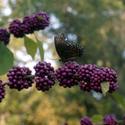 All About American Beautyberry
All About American BeautyberryI really look forward to fall when so many plants change into their colorful fall wardrobes; it's such a beautiful sight. The American Beautyberry is one such plant that makes quite a showing, boasting bright magenta berries that look much like bracelets of amethyst beads glistening in clusters along drooping branches.
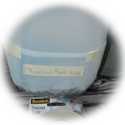 Winter Sowing and Freezer Tape
Winter Sowing and Freezer TapeFreezer tape is useful for wintersowing because it will hold up to the elements outdoors.
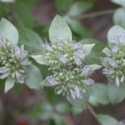 Mountain Mint
Mountain MintThere are many wonderful native herbaceous plants and flowers growing in the wild that are all too often overlooked or forgotten. I think this is one of them.
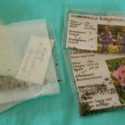 Clinging Seeds Solution
Clinging Seeds SolutionFor those seeds that are clinging to the inside walls of the plastic or cellophane seed packets, making it almost impossible to get them out, I found that rubbing the packet with a fabric softener sheet (dryer sheet) does a good job of stopping static cling.
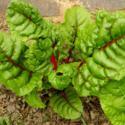 Get the Most out of Your Swiss Chard
Get the Most out of Your Swiss ChardCut your Swiss chard back in late summer and it will resprout, growing new leaves for a fall harvest and well into the winter.
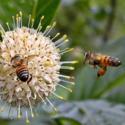 Wildflowers Attract Pollinators to Your Gardens
Wildflowers Attract Pollinators to Your GardensDo you want to attract bees, butterflies, and/or hummingbirds to your garden? The best way to lure pollinators into your garden is to plant things they love. Pollinators love wildflowers. These are a few of my favorites that are loved by pollinators and are easy to grow.
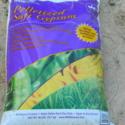 Improve Clay Soil
Improve Clay SoilThis isn't a quick fix, but if you have areas where you simply cannot garden due to the heavy clay soil, Gypsum (aka calcium sulfate) can improve the soil structure. There's no need to dig or till the gypsum in. Just add it to the top of the clay soil. The Gypsum will break up the clay on a molecular level, allowing water to permeate through. It's best to apply several applications (over a year or more) before you add your other amendments and finally begin your new garden. We've done this and I think it's worth the time. Gypsum can also be used to remove sodium from saline soils.
 Make Your Own Hummingbird Nectar
Make Your Own Hummingbird NectarHummingbirds love the nectar made with this easy recipe.
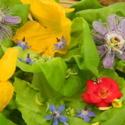 Grow Edible Flowers
Grow Edible FlowersMaybe you've been considering the addition of edibles to your garden, but you aren't willing to give up the beauty that only flowers can provide. The solution: Grow edible flowers! This list of edible flowers can easily be grown in your garden. In fact, some of them might already be growing there.
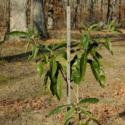 Tree Planting Tip
Tree Planting TipIf you are staking your new tree, make sure to hammer the stake in first. If you wait and put the stake in after planting your tree, the stake could hit and damage the roots.
 Glossary Tip - Cotyledon
Glossary Tip - CotyledonWhen the seed of a plant germinates, that first leaf or set of leaves to unfold is called a cotyledon. Cotyledons are developed by the embryo of the seed and are sometimes called seed-leaves. They contain stored food reserves from the seed, used to keep the seedling fed until the next set of leaves, considered the "true leaves," appears. Once the second set of true leaves sprouts, the plant will begin photosynthesis. The cotyledons will wither and disappear soon after the true leaves start to grow.
 Cleaning Root Vegetables
Cleaning Root VegetablesA pair of exfoliating bath and shower gloves works very well for cleaning garden fresh root vegetables.
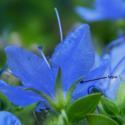 Glossary Tip - Sepal
Glossary Tip - SepalSepals are the leaf-like structure found between the top of the stock and the petals (corolla) of flowers. Look on the underside of the flower petals to find the sepal.
 Glossary Tip: Corolla
Glossary Tip: CorollaTwo or more petals on a flower, that are usually a color other than green, are known collectively as the "corolla."
 Glossary Tip - Monoecious
Glossary Tip - MonoeciousA "Monoecious" plant has male and female flowers living on the same plant. They are considered imperfect flowers. Squash is an example of a monoecious plant. In the image the male flower is on the left, the female flower on the right.
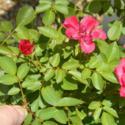 A Snip Tip
A Snip TipTo deadhead spent flowers from plants, I usually just pinch the faded blooms and stem above the leaf node with my fingers. If it's a side shoot, just snip it off with the garden scissors.
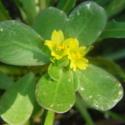 Purslane, a Good Weed
Purslane, a Good WeedHere's another plant that most consider a weed, but let's take a look at all it offers before we start tossing it aside.
 A Quick Tomato Tip
A Quick Tomato TipTo have a supply of fresh home grown tomatoes into fall and until the first frost, you might want to consider planting some new plants now (July). If you have a long enough growing season, plant transplants, cuttings from existing plants or from seed. When your spring plants are done producing, the summer plantings will just be starting!
 A Quick Potting Tip
A Quick Potting TipWhen potting plants, put some fallen leaves in the bottom half of the pot and then add potting soil. The leaves will keep the water draining and hold the soil in. Over time the leaves will compost, which really makes the plants happy. It works especially well with big pots, cutting down on your potting soil expense!
 Giant Swallowtail Butterflies and Your Citrus Trees
Giant Swallowtail Butterflies and Your Citrus TreesIt started out as a usual morning as I hand watered the front garden; then I noticed what looked like bird droppings all over one of the lime trees.
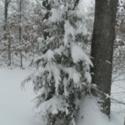 Remove Heavy Snow Early
Remove Heavy Snow EarlyBrush snow from evergreens as soon as possible after a storm by using a broom in an upward, sweeping motion. Heavy snow or ice accumulating on the branches can cause serious damage.
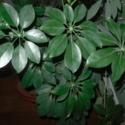 Clean Your Houseplants
Clean Your HouseplantsHouseplants with large leaves and smooth foliage, such as schefflera, philodendrons, and rubber plants, benefit from periodically washing the leaves to remove dust buildup, helping to keep the leaf pores open.
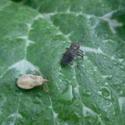 Squash Bug Eggs
Squash Bug EggsIf you find squash bugs on your squash or other veggies in the garden, make it a point to look on the underside of the leaves where they have likely left eggs which will hatch in 5 to 10 days! Don't forget to remove the bugs and the eggs!
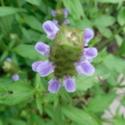 All-Heal, Heart of the Earth
All-Heal, Heart of the EarthSome may call it a common weed while others call it a wildflower, or as its name implies some still call it a medicinal herb. All-heal grows practically all over the world and has been regarded as a healing plant since ancient times.
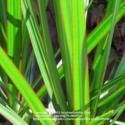 It's All About Leaves
It's All About LeavesLeaves so often take a back seat to the more showy and colorful flowering blooms and fruits. While we wait for spring to arrive, let's take a look at leaves as the star attraction.
 A Gardener's New Year Resolution
A Gardener's New Year ResolutionAs we enter the new year, I want to extend my warmest wishes to all my garden friends. May your gardens flourish and may you and yours have a healthy, prosperous, joy-filled New Year.
 Plants Native to Your Region Will Grow Without Much Effort
Plants Native to Your Region Will Grow Without Much EffortNative plants and flowers are adapted to the specific conditions of your region, making them durable and easy to grow, as well as beautiful additions to the garden.
 All About Mistletoe
All About MistletoeThe Christmas season is upon us; a time of traditions and celebrations and just maybe a kiss under the mistletoe.
 All About Horehound
All About HorehoundA nice hot cup of horehound tea with honey and lemon and a warm slice of banana nut bread covered in melted butter. That's one of my fondest childhood memories. With winter and the holidays just around the corner, I'm reminded of horehound and what a special herb it is.
 All About the Eastern Red Cedar
All About the Eastern Red CedarIf I were asked what I love most about this tree, I probably couldn't give just one attribute, but the first thing that comes to mind is how much I enjoy the pleasant fragrance the tree emits, and how its handsome stature makes a perfect Christmas tree. But then maybe it's because it's so beneficial to songbirds and other wildlife, protecting and feeding so many over winter. Or maybe it's how much history the tree has, or how it provides medicine for many.
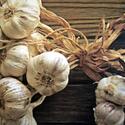 All About Garlic
All About GarlicGarlic is one of my favorite flavorings to use in the kitchen and one of the easiest of all the herbs to grow in the garden. If you absolutely love the smell and flavor of fresh garlic, or have ever considered growing your own garlic, this fall would be a really good time to plant some cloves. It takes little effort to grow them yourself and you will be rewarded with juicy and flavorsome bulbs.
 Dried Seed Heads Will Feed the Birds During the Winter
Dried Seed Heads Will Feed the Birds During the WinterLeave the flower heads of Black-eyed Susan, (Rudbeckia) over winter. Although not particularly attractive all dried out, the seed heads will feed the birds.
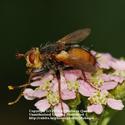 Welcoming Beneficial Insects to the Garden
Welcoming Beneficial Insects to the GardenNature is filled with a wide variety of beneficial insects whose diet consists mainly of the little pests that invade your gardens. Yes, there really are "good bugs" and they are a great way to combat the pests that are ready and waiting to devour and destroy your plants. Some of these good guys may have been hanging around and you didn't realize they were actually keeping pests off of your favorite flowers or vegetables. Let's take a look at some of these beneficial predatory insects so you can learn who your allies are.
 Introducing Heirlooms for the Beginner Gardener
Introducing Heirlooms for the Beginner GardenerHeirlooms are a perfect choice for the beginner gardener. The seeds of many of these old cultivars have been saved and passed down for generations because of their easy-to-grow habits. They are those wonderful old fashioned flowers that your grandmother grew forever in her garden, or those delicious tasting tomatoes that you might remember eating as a child. But it doesn't stop there; as you begin to consider growing heirlooms, you will discover many unique and interesting flowers, herbs, vegetables and fruits.
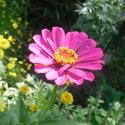 Companion Planting: A Reliable Option or Nonsense?
Companion Planting: A Reliable Option or Nonsense?So what about Companion Planting? Is it merely folk lore and old wives' tales without any scientific evidence to back it up? Or can you create a beautiful garden that flourishes in rhythm with the natural balance that mother earth has to offer (without the use of pesticides or other harmful chemicals) by using companion planting practices? Maybe some traditions and folklore were created for a reason.
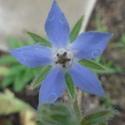 Borage for Courage
Borage for CourageThis beautiful plant is said to bring courage to the heart and drive away all sadness. And that's just the beginning of all the lovely virtues of this herb. Borage is also a great companion to some of your garden favorites. Bees love the nectar rich flowers. I like to add the vibrant blue flowers to salads but they are also great candied for desserts or fresh in beverages. You can make your own flowery ice cubes with your garden edibles, there are easy instructions at the end of this article.
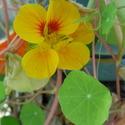 Talking About Nasturtiums
Talking About NasturtiumsI have a personal fondness for this old-fashioned flower. Its delicate fragrance takes me back to when I was a young girl spending many hours in the garden. The taste of the sweet nectar from the spur of the nasturtium, the skipper butterflies fluttering around, and the ladybugs . . . I'm transported back in time.